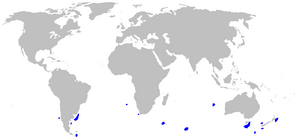Southern sleeper shark facts for kids
Quick facts for kids Southern sleeper shark |
|
|---|---|
 |
|
| Conservation status | |
| Scientific classification | |
| Genus: |
Somniosus
|
| Species: |
antarcticus
|
 |
|
| Range (in blue) | |
The southern sleeper shark, also known as Whitley's sleeper shark (Somniosus antarcticus), is a fascinating shark that lives deep in the ocean. It's a type of sleeper shark found in the very cold, southern parts of the Atlantic, Indian, and Pacific Oceans. You can find it near places like southern South America, South Africa, Australia, and New Zealand.
Contents
About the Southern Sleeper Shark
This shark is a "benthopelagic" creature. This means it lives both near the ocean floor (benthic) and in the open water (pelagic). It belongs to a group of sharks called Somniosidae.
Where it Lives
The southern sleeper shark loves deep, cold water. It usually hangs out at depths from about 400 meters (1,312 feet) down to 1,100 meters (3,608 feet). That's super deep, where it's very dark and cold!
What it Looks Like
This shark can grow quite large, up to about 4.4 meters (14.4 feet) long. That's longer than a typical car!
It has some unique features that help scientists tell it apart from other similar sharks:
- It has more rows of teeth in its lower jaw compared to the Greenland shark.
- Its first dorsal fin (the fin on its back) is placed further back on its body.
- Its dorsal fins are lower than those of the Greenland shark and the Pacific sleeper shark.
What it Eats
The southern sleeper shark is a slow-moving shark. Because of this, scientists think it's an "ambush predator." This means it waits quietly and then suddenly attacks its prey.
Its main diet includes:
- Cephalopods: These are sea creatures like squid. It even eats giant and colossal squids!
- Various fishes.
Sometimes, scientists have found parts of marine mammals or seabirds in their stomachs. This probably happens when the shark finds and eats dead animals that have sunk to the ocean floor. One amazing discovery was a whole southern right whale dolphin found inside a 3.6-meter (11.8 feet) long female shark caught near Chile!
Sometimes, these sharks are accidentally caught by fishing boats. This is called "bycatch." Scientists are still studying if this is a problem for the southern sleeper shark's population.
How We Protect It
Good news! The southern sleeper shark is currently considered "Not Threatened" by conservation groups. This means it's not in immediate danger of disappearing.
However, there's still a lot we don't know about this deep-sea shark. Scientists say we need more information about:
- How many southern sleeper sharks there are.
- How they interact with other animals.
- More about their lives and habits.
This information will help make sure these amazing sharks stay safe in our oceans for a long time.


